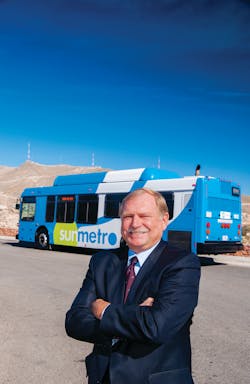When Joyce Wilson took over as El Paso city manager in 2004, she found herself facing down a massive crisis with the city’s public transit system, Sun Metro.
By 2005, she said there were indicators of “major stress” on the system, which prompted city leaders to do a radical intervention before Sun Metro ceased to exist.
Wilson said a big issue the system faced was projects were cobbled together using federal grants, with no game plan. It was difficult to get federal monies as well because Joyce said federally elected representatives said plans presented to them didn’t highlight a game plan.
“When the crisis hit, it became really apparent that we had to really do something dramatic or we were not going to have a transit system,” Wilson said.
El Paso began a dramatic change in how Sun Metro was being run and how it focused on serving its community. And within six years, the changes were dramatic enough to take Sun Metro from the edge of extinction to being recognized by the American Public Transportation Association (APTA) as the best midsized system in the country.
Overhauling the management
First Transit took over the system in 2007 and found Sun Metro in need of some care. Tim Omick was the initial First Transit manager of Sun Metro and began to lay the ground work to overhaul it and “shock the system,” before Jay Banasiak took over in 2009.
First Transit needed to revamp the entire system, which Banasiak said meant getting down to changing the basic outlook and attitudes of employees who had worked in a system trying to just hang onto what it had.
“Before 2007, the system was really stressed out and struggling and the employees got used to that, so basically they were city employees and that’s how they ran it,” he said. “When we were first hired at First Transit, we were told ‘I want to be one of the best transit systems around,’ so we had to get the employees to buy into the fact they’re not really city employees per say, but transit professionals.
“They think like that now. They bought into the system and we really take care of them for all the new things coming and we try to do as many incentives as we can.”
While First Transit was the one implementing the changes at Sun Metro, leaders said the pro-public transit attitude adopted by city leaders made the changes possible.
“We had a good core of employees and knowledgeable people, but there was no direction or support,” said Lloyd Williams, assistant director of operations for Sun Metro. “It was about changing the culture a little bit and believing in it, so when they saw the new buildings going up it helped changed the mentality of the people who really wanted to help in what we were doing.”
Williams said there was loads of employee grievances filed with the agency when First Transit took over, so leaders took steps to tackle them by listening to employees and addressing issues.
Although workers aren’t unionized, a quasi-union leader filed lots of grievances, so Williams said the employee was named to a supervisory position in order to give him a chance to make a positive change.
“We’re not in the bus business, we’re in the people business,” Williams said.
The takeover meant First Transit also hired a lot of new people with a new focus on customer service for those hired as opposed to existing driving skills.
El Paso is a very linear town because of the nearby mountain ranges, so it stretches out further than his previous locations.
“People are more apt to use transit here,” Banasiak said. “People from Jaurez, Mexico need transit to get to work, so the biggest expectation here is to provide really good service.”
When First Transit first took over Sun Metro employee attitudes and outlooks weren’t the only things that needed to be fixed as an archaic bus fleet sat in in wait for some care after years of neglect.
Kevin Bunce, assistant director of maintenance for Sun Metro, said buses on the system have a 12-year or 500,000 mile life cycle, but when the system began retrofitting diesel buses to run on natural gas in the 1990’s it changed the lifecycle of the buses, meaning the agency had to wait much longer to replace them.
And the way the agency approached service to its fleet made it very difficult to keep buses on the road.
“When I first came here in 2006, the on-time performance was measured in if the bus actually showed up at all much less on time. It was that awful,” he said. “Now we have a 97 percent on-time performance and that’s measured by when it’s supposed to show up not if it’s going to show.”
Sun Metro began pushing more preventative maintenance on its bus fleets, Bunce said, instead of waiting for the units to break. Once it became priority one of the maintenance shop, they then put an emphasis of getting OEM replacement parts as opposed to “parts that just fit.”
The usage of OEM parts has saved the agency significantly because it keeps the buses on the roads because there’s less failure by cheaper aftermarket parts, which can wreck other parts of the bus when they fail.
Local vendors also bid to sell OEM parts to the agency as well, Bunce said, so if they need to get something like Bendix brakes they get the best price possible from local suppliers who bid to sell the parts.
“There’s some pretty interesting characters out there selling some pretty interesting things,” he said. “We use the phrase that sometimes I can’t afford to have you save me any money.”
Bunce said maintenance department leaders are still changing attitudes to this day because some of them liked the old system, but when a new bus is purchases all technicians must undergo extensive OEM training to make sure they can fix all the components.
“We can go out and buy the best bus there is, but if my techs don’t know how to work on it, then it’s a piece of crap,” he said.
On-time performance for Sun Metro is 97 to 98 percent Banasiak said road calls continue to decline despite the system’s aging fleet.
“Probably the biggest reason we’ll continue to be successful is our employees,” Banasiak said. “They understand what we want to do and they understand we’re the best transit system and we want to continue being the best.”
Sun Metro has even tackled vandalism issues by teaming up with an El Paso community organization. Graffiti was an issue on display boards at the transit centers, so the agency reached out to Creative Kids, which put different Hispanic artwork displays in areas that had been popular targets for graffitists.
The artwork is created by children from low income families or children who have terminal diseases or are battling disabilities.
“It’s a good opportunity to showcase some of the wonderful pieces of art the children made and share them with our community as well as help stop or reduce graffiti and tagging,” Banasiak said. “It really has. We hardly get tagged anymore.”
Birth of a world-class system
After the system was stabilized, Wilson said El Paso leaders were able to get out of the crisis mode and develop a forward thinking strategy for Sun Metro.
“We’re a large urban area with about 700,000 people in the city and slightly less than 1 million in the region and that doesn’t count our Mexican visitors who use the system,” she said. “We need to have a world-class, reliable public transit system for this community if we’re going to be competitive with other cities.”
Sun Metro is putting an emphasis on improving customer experiences. Banasiak said in the past several years the agency has spent $8 million on new shelters along with $31 million building four new transit centers. Each of the centers has Wi-Fi and real time displays so riders know exactly when their bus will arrive.
The agency has even partnered with Big Boy Concessions to open a restaurant in the centers, so riders have a chance to get something to eat while waiting for their ride.
The downtown transit center draws 20,000 riders per day, Banasiak said, so the demand is there for amenities to improve their ride.
“We take care of our passengers because we figure if we have a 97-98 percent on-time schedule, buses seldom break down and we give people accurate information, that’s all we can do,” Banasiak said.
Sun Metro will soon go out to bid to get riders next bus information via computer and smart phones by late summer or early fall.
“Passengers will have that information literally at the tips of their fingers,” Banasiak said. “They can know exactly when their bus will be there.”
Sun Metro also has a working relationship with Amtrak, which leases agency space in the depot. It also works with the New Mexico Department of Transportation, which runs a route from La Cruces, N.M., into El Paso.
“It has been a great commuter system,” Banasiak said. “My wife uses it all the time and it’s full.”
Bunce said the Sun Metro fleet consists of 103 North American Buses, 39 New Flyers and 25 Millenniums. The 1991 models will finally be replaced in July.
The old buses need plenty of work because of El Paso’s location. The city is 4,000 feet above sea level, with summertime temperatures reaching 100 degrees, so Bunce said it’s not uncommon for turbo chargers to be glowing red, so cooling systems need to be pretty robust.
The air conditioning units have to contend with cold air escaping the buses in the summer when bus doors open and because of the dust and dirt severe duty air filters from makers like Fleet Guard are needed to keep the systems clean.
“Again, it’s about spending the money up front on the durability instead of on the back end when it breaks down.” Bunce said.
Sun Metro is also completing a $38 operations center, which is a very welcoming addition for the maintenance department, Brunce said because right now roughly 167 buses are being stored on 13.5 acres, while the new center will have 37.5 acres and fit upwards of 270 buses.
And the facility will open up just in time for the arrival of new articulated buses, which will run in what could become the crown jewel of Sun Metro.
A new standard in BRT
Sun Metro is building a $140 million four-corridor bus rapid transit system, which will feature 100 stations along 50 miles of line. Banasiak said each of the stations will also have Wi-Fi allowing riders to use electronic devices seamlessly along their commute.
“One of the biggest things now that we have the infrastructure set and we have this BRT system is now it’s all about economic development,” Banasiak said. “It’s about how we can utilize our BRT corridors to make the economy better.”
Banasiak said the most exciting transit-oriented development associated with the BRT is happening in the northeast part of El Paso on the site of a former mall. The 30 acre mall had not been used in at least a decade, so Sun Metro bought seven acres for $5 million to build a transit center on it. The purchase spurred the city to buy the other 23 acres, raze buildings on the site and now Sun Metro is in negotiations with a major developer to put up a major TOD development, which also recently received a $10 TIGER grant.
Banasiak said the project is looking at building 130,000 square feet of retail space; 800 residential units; 480 parking spaces; and 7,300 linear feet of street. It could be a $130 million development, Banasiak said, and the terminus will be a BRT route, which has gotten the attention of the Federal Transit Authority.
The development is also near Fort Bliss, which has seen its population swell from 30,000 to 100,000 in recent years due to $5 billion in investments from the federal government. FTA Administrator Peter Rogoff even came out to see the TOD project, which Banasiak said is creating excitement for federal leaders.
“This is a major TOD development usually reserved for a light rail system,” Banasiak said. “Everyone is really excited about how it’s going to turn out.
“And that’s the big thing. You know, when you looked at the property before, it was rundown, now it’s nothing by flat land, ready to be developed, so it’s really exciting and the city is really excited. The people were there for the breaking down of the old mall. You should have seen the crowd when that first ball hit the side of that building. There’s a lot of anticipation for that area.”
In addition to the BRT, Sun Metro has completed design work on a five mile streetcar line. The project needs money is Banasiak said it’s “on the back burner” right now, but’s ready to go if funding comes through.
Michael O. Herrera, assistant director for planning ,safety, security and training, said new system leaders inherited an outdate transit system comprised of several former bus operators who were merged into one entity by the city and there was little thought given to the way routes were designed or to growth of the city to better serve residents.
Now Sun Metro is involved in city planning and development process.
“One thing we worked on was making sure we had a place in the development process and to do any development — large or small scale — we need to sign off on it because now there’s a transit element,” he said.
Aiming for the next level of success
Sun Metro is an enterprise fund with its local funding coming from a one-half cent sales tax. Fare box recovery is at about 23 percent, with the goal of getting to 25 percent in coming years.
In order to keep things in top running order, Sun Metro has turned to public-private partnerships to fund projects, such as adding benches at bus stops. Banasiak said the agency works with three bench franchisers, which gives Sun Metro a little bit of income and there are now benches at more than 1,500 of the 2,800 stops in the system.
Sun Metro also works with local colleges, such as the University of Texas El Paso, which, Banasiak said leases the agency parking spaces near a transit station. Sun Metro is working with El Paso Community College to create a pass system for students and with the move into the new operations center, Texas Tech will move its school of architecture into the depot.
Banasiak said the school is partially leasing the building right now, but will move completely into the facility once Sun Metro vacates it.
Herrera said Sun Metro recently hired a TOD manager and the agency looks at land developments not only in the city and county, but in a scope of how it connects interstate.
“We’re striving for a truly multi-modal system with all different means of transportation,” Herrera said. “We just recently approved for a pilot ride sharing program that has been in the works for two or three years and was finally given funding.”
Rail also figures into Sun Metro’s and El Paso’s future. Herrera said New Mexico’s Road Runner service is looking to eventually expand into the city and La Cruces.
“Eventually we want to evolve our RTS system into light rail,” he said. “That’s what the future hold for us.”
Recently the agency has begun switching to predictive maintenance, Bunce said, by using data to predict when a part may fail, then replace it before it does so without replacing it while there’s still lots of life left on the part. The change allows technicians to rebuilt parts at a less expansive cost, so there are most cost savings to the agency.
Bunce said service crews emphasize cleanliness on Sun Metro buses and the only time there’s a complaint about a dirty bus from a driver it’s not because someone did a bad job, it’s because someone missed the bus.
“Even though we’ve got this really old bus, our response is that we can have a really old clean bus,” Brunce said. “Just because it’s old doesn’t mean it isn’t clean.”
The change in attitude is paying off and the future is bright in El Paso.
“Our ridership has increased by almost 3 million annually, so it’s clear to me that those are choice riders who don’t have to use the system,” Wilson said.
From 2009 to 2012, ridership increased 21 percent on Sun Metro, raising ridership to more than 17 million. And given the pace the system is growing and the accolades its getting, Banasiak said El Paso is setting up its own expectations for Sun Metro in coming years especially given its win as the APTA’s midsized system of the year and how close it is to moving to the next category of competition, which requires 20 million riders.
“Our goal is to win the large system APTA award,” Banasiak said. “Our goal is 20 million riders and we should hit 20 million with the BRT system.”

Joe Petrie | Associate Editor
I came to Mass Transit in 2013 after spending seven years on the daily newsbeat in southeastern Wisconsin.
Based in Milwaukee, I worked as a daily newspaper reporter with the Waukesha Freeman from 2006-2011, where I covered education, county and state government. I went on to cover courts for Patch.com, where I was the main courts reporter in the Metro Milwaukee cluster of websites.
I’ve won multiple awards during the course of my career and have covered some of the biggest political events in the past decade and have appeared on national programs.
Having covered local government and social issues, I discovered the importance of transit and the impact it can have on communities when implemented, supported and funded.


